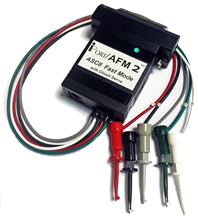The iPort/AFM 2 (#MIIC-213) is an important addition to MCC's RS-232-based I2C Bus host adapter product line, offering a full range of voltage and performance capabilities required for the design and production of products using the latest generation of ICs and sensors.
This product brief describes features and benefits of the iPort/AFM 2 (#MIIC-213) I2C Bus host adapter, and indicates differences between the iPort/AFM 2 (#MIIC-213) and the previous generation iPort/AI (#MIIC-202) and iPort/AFM (#MIIC-203).
In addition to the information provided below, detailed product information, drivers, development tools, and application software is available on the iPort/AFM 2 Resource Page (http://www.mcc-us.com/iPortAFM-2).
Please note that the iPort/AFM 2 is available in singles with I2C Bus Mini Clip-Lead Cable, RS-232 Cable, Power Supply, and carrying case, or in 5 and 10 packs without cables, power supplies, or cases. We also offer standard and custom length I2C Bus cables.
 |
 |
 |
Features, Benefits, and Differences:
1. Faster Throughput
Feature: The iPort/AFM 2 (#MIIC-213) uses a new faster chipset.
Benefit: The iPort/AFM 2 can communicate more data faster for I2C Bus data intensive applications.
Difference: 2x times faster than the iPort/AFM (#MIIC-203), and up to 100x times faster than the iPort/AI (#MIIC-202).
2. Circuit SenseTM, Integrated Voltage Translation
Feature: The iPort/AFM 2 (#MIIC-213) includes a new switch-selectable integrated Circuit Sense I2C Bus voltage level translation circuit. Circuit Sense allows iPort/AFM 2 to work with a wide range of I2C Bus voltages from 0.5 volt to 5 volt.
Benefit: The iPort/AFM 2 can adapt to a userís circuit High Logic Voltage Level (1) and Low Logic Voltage Level (0) based upon a user reference voltage signal.
Benefit: The iPort/AFM 2 can work with very low voltage user devices, like battery powered watches and fitness bands, while also working with standard 1.8v, 3.3v, and 5v devices.
Benefit: The iPort/AFM 2 can communicate with advanced low-voltage sensors.
Benefit: The iPort/AFM 2 can adapt to a userís circuit voltage in real-time, so the iPort/AFM 2 can automatically adjust logic levels to the battery or power supply voltage in a userís device.
Difference: The iPort/AFM (#MIIC-203) and iPort/AI (#MIIC-202) communicates with 3.3v to 5v only devices, and requires an external voltage translation adapter to work down to 1.8v.
3. Integrated I2C Bus Pull-ups
Feature: The iPort/AFM 2 (#MIIC-213) includes integrated slide switch controlled pull-ups. This allows the iPort/AFM 2 to provide 5v Fixed Pull-ups, External Circuit Voltage Pull-ups, or No Pull-ups to the I2C Bus.
Benefit: The iPort/AFM 2 can supply a wide range of I2C Bus pull-up options for user circuits.
Difference: The iPort/AFM (#MIIC-203) and iPort/AI (#MIIC-202) can only supply 5v or no pull-up for a userís circuit.
4. Mini I2C Bus Connector
Feature: The iPort/AFM 2 (#MIIC-213) includes our new low-profile I2C Bus mini interface connector (http://www.mcc-us.com/I2CMiniInterfaceInfo.html).
Benefit: Custom I2C Bus cables are easier to make. Eliminates need for expensive cable making tools.
Benefit: Positive locking prevents accidental disconnection.
Benefit: Keyed to prevent reverse insertion.
Benefit: Low-profile fits in small spaces.
Difference: The iPort/AFM (#MIIC-203) and iPort/AI (#MIIC-202) use a high-profile connector that required special cable making tools (http://www.mcc-us.com/ipicon.htm).
5. Power Options
Feature: The iPort/AFM 2 (#MIIC-213) can be powered from a modular 5v power supply, or from I2C Bus 5v power.
Benefit: The iPort/AFM 2 can supply 5v power to a user's circuit via the I2C Bus.
Benefit: The iPort/AFM 2 can be powered from the user's 5v circuit.
Difference: No difference. Compatible with existing iPort/AFM (#MIIC-203) and iPort/AI (#MIIC-202) power systems
6. I2C Bus Circuit Protection
Feature: The iPort/AFM 2 (#MIIC-213) includes a three-stage advanced I2C Bus Over-Voltage, Reverse-Voltage, and ESD protection circuitry.
Benefit: Helps protect a userís host computer if a high or reverse voltage or power spike is accidentally attached to the I2C Bus.
Benefit: Helps protect the iPort/AFM 2 if a high or reverse voltage or power spike is accidentally attached to the I2C Bus.
Difference: The iPort/AFM (#MIIC-203) and iPort/AI (#MIIC-202) includes limited ESD protection.
7. Application Software Compatible
Feature: The iPort/AFM 2 (#MIIC-213) is software compatible with all our ASCII-text based I2C Bus adapters including the iPort/AI (#MIIC-202), iPort/AFM (#MIIC-203), iPort/USB (#MIIC-204), iPort/LAN (#MIIC-205), i2cStick (#MIIC-207), and the new iPort/USB 2 (#MIIC-208).
Benefit: User custom application software may not need any changes to use the iPort/AFM 2.
Benefit: Compatible with MCC's MS.NET Class Library and LabVIEW VI Library.
Benefit: User systems designed to work with one type of MCC adapter interface (RS-232, USB, or Ethernet) can move to another interface type without the need to re-program custom application software.
Benefit: Extends the useful life of user's custom application software, product programming environment, and production test systems.
Any questions? Ask our support team (support@mcc-us.com).
I2C is just a mouse click away TM
